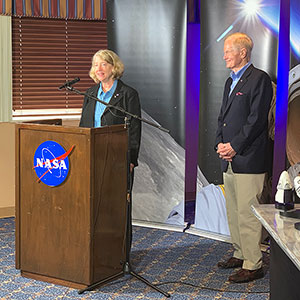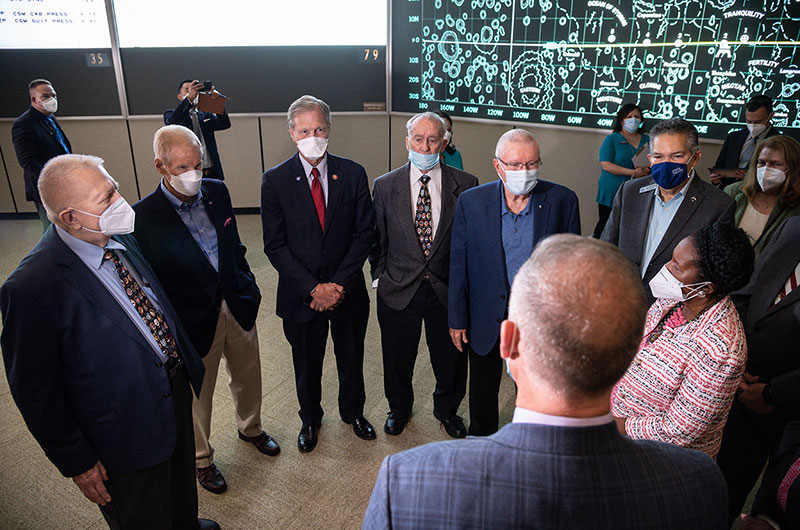 advertisements advertisements
|

|
NASA Administrator looks to future on visit to Johnson Space Center
September 2, 2021 — Bill Nelson's trip to the Johnson Space Center in Houston this week evoked memories of his first visit to the home of U.S. human spaceflight more than 35 years ago.
Now a former senator and the current head of NASA, Nelson was a member of the U.S. House of Representatives when he first reported to Johnson in 1985. After several months of training, Nelson became the second congressional observer fly into Earth orbit, lifting off as a payload specialist on the last space shuttle mission before the Challenger tragedy in January 1986.
"I had the privilege of spending some time here," Nelson told reporters at Johnson Space Center on Thursday (Sep. 2.). "I discovered my fondness for chicken fajitas here."
"What are my thoughts as I come back to Johnson? I am ready to go down there and suit up," Nelson said with a laugh.
Part of his ongoing tour of the space agency's field centers since becoming NASA Administrator in May, Nelson was joined by Johnson director Vanessa Wyche and Deputy NASA Administrator Pam Melroy, who also trained at Johnson as a former NASA astronaut and one of only two women to command the space shuttle.
"It is fantastic to be back here," said Melroy. "Obviously, Johnson Space Center is known as being a key center for human spaceflight — the astronauts all train and live here. In addition to that, we are very proud of mission control as well, which is an additional gem in its own right."
Johnson Space Center oversees the operation of the International Space Station; development of the Orion spacecraft and Gateway lunar outpost; and commercial low Earth orbit programs. It also serves as the primary training facility for NASA's astronaut corps, who are currently preparing for missions to the space station on commercial spacecraft and for flights aboard Orion as part of Artemis missions to the moon.
Though part of Nelson's visit included meeting Apollo astronauts Fred Haise and Walt Cunningham, as well as Apollo-era flight director Gene Kranz, his focus was set squarely on the future.
"We know that this is a whole new generation of explorers and what we want to do is build on the shoulders of those who we met with today, the Apollo generation," said Nelson. "We want this to be the Artemis generation. We want this Artemis generation to soar, which is going back to the moon and onto Mars and to explore the heavens, and that's our supporting role."
On Thursday morning, Nelson and Melroy, as well as members of the Houston Congressional delegation, had the opportunity to talk with the crew on board the International Space Station from inside mission control.
"I just can't tell you how awesome it is to see all of you, just the wonderful diversity of all of the crew," Melroy said, addressing the seven-person Expedition 65 crew. "I think one of the most special parts about helping to build the International Space Station was flying with all of our partners and learning their cultures, sharing food together and sharing hard work together."
In addition to three American astronauts, a French astronaut representing the European Space Agency (ESA) and a JAXA (Japan Aerospace Exploration Agency) astronaut, Melroy and Nelson also spoke to the two Russian cosmonauts on board. Recent comments made by Nelson's counterpart at Roscosmos, Russia's federal space corporation, have called into question Russia's interest in remaining partners in the International Space Station and with NASA in general.
Nelson, however, said he did not see this as the beginning of the end of Russia and the U.S. working together in space, a legacy that goes back to 1975 and the Apollo-Soyuz Test Project.
"To the contrary of ending, it's just continuing," Nelson said, replying to a question from collectSPACE. "I believe in the conversations that I've had with [Roscosmos Director General] Dmitry Rogozin [that] we're going to have continued cooperation with them."
"They just put up a major module," he said, referring to the Nauka multipurpose laboratory module. "If they were getting ready to abandon the space station, obviously they wouldn't have done that. And I can tell you that I have information that all the cosmonauts certainly want to keep the cooperation going."
"So I'm very encouraged in that, and just as soon as the COVID [pandemic] will allow, Pam and I are getting on an airplane and we're going to go see Rogozin," said Nelson. "So I look forward to a very strong partnership with the Russians and I hope that we will have a partnership with them at or around or on the moon." |
|

NASA Administrator Bill Nelson, a former space shuttle payload specialist, takes questions from reporters at Johnson Space Center in Houston, Texas on Thursday, Sept. 2, 2021. (collectSPACE)

NASA Administrator Bill Nelson (at right) and Deputy Administrator Pam Melroy (second from right) talk with astronaut Suni Williams who is training at Johnson Space Center to fly on Boeing's Starliner spacecraft to the International Space Station. (NASA)

NASA Deputy Administrator Pam Melroy talks to reporters at the Johnson Space Center in Houston, Texas as NASA Administrator Bill Nelson looks on, Thursday, Sept. 2, 2021. (collectSPACE) |

NASA Administrator Bill Nelson (second from left) and members of the Houston Congressional delegation meets with veteran flight director Gene Kranz (at left) and Apollo astronauts Walt Cunningham and Fred Haise (fourth and fifth from left) in the restored Historic Mission Control at Johnson Space Center in Houston, Texas, on Thursday, Sept. 2, 2021. (NASA) |
|

© collectSPACE. All rights reserved.
|
|

|

|
